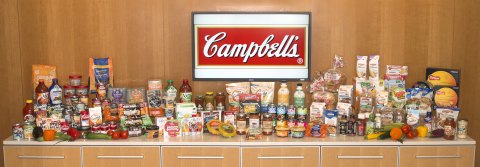CAMDEN, N.J.--(BUSINESS WIRE)--Campbell Soup Company (NYSE: CPB) today outlined its strategies to drive growth in a rapidly-changing food landscape at its annual investor day. Led by President and Chief Executive Officer Denise Morrison, the company declared its goal to be the leading health and well-being food company. Executives detailed plans to strengthen Campbell’s core business and expand into faster-growing spaces through four strategic imperatives:
- Building greater trust with consumers through real food, transparency and sustainability;
- Accelerating digital marketing and e-commerce efforts;
- Continuing to diversify Campbell’s portfolio in fresh foods and health and well-being; and
- Increasing its presence in the faster-growing snacking category.
Morrison said, “In the last six years, we've made significant progress activating our Purpose, 'Real Food that Matters for Life's Moments,’ and transforming our portfolio toward faster-growing spaces. Our intention has been to move Campbell in the direction of health and well-being. We are committed to accelerating those efforts and strive to be the leading health and well-being food company because we recognize that real food and healthier food is better for our consumers and better for our business.”
Today, Campbell has approximately $1 billion in annual net sales from fresh products and its portfolio provides nearly 15 billion servings of vegetables and more than 2.4 million tons of whole grains to consumers annually. The company’s organic portfolio is in the top 10 in the industry and growing at double digits.
In response to changing consumer needs around health and well-being, Campbell has taken deliberate steps to reshape its portfolio through internal innovation, changes to its recipes and a series of acquisitions, including Bolthouse Farms, Plum Organics, and Garden Fresh Gourmet, as well as the pending acquisition of Pacific Foods, a leading producer of organic broth and soup.
Morrison said, “Campbell‘s goal to lead in health and well-being is attainable, but we will need to redouble our efforts by extending the real food credentials of our current brands and adding more brands that resonate with consumers; improving our rate of innovation; and increasing our distribution capabilities in new channels. Some of this we can build ourselves, but in other instances we will have to leverage external development.”
Ed Carolan, President – Campbell Fresh, discussed the division's portfolio role to accelerate CPG sales growth and expand into new categories, as he outlined plans to return the division to growth through a combination of increased beverage capacity, improved customer service levels, more effective agricultural strategies and higher levels of marketing, with continued focus on innovation and quality standards.
Building Trust Through Real Food, Transparency and Sustainability
Campbell unveiled an agreement with The Sage Project to partner on digital disclosure of ingredients using Sage’s food data platform. Combining technology with design, Sage is creating online food labels for the digital world, making information about calories, nutrition, ingredients and attributes open, accessible and easy for consumers to understand. Campbell’s Well Yes! soup varieties are the first products to bring The Sage Project’s SKU level transparency to Campbell’s platforms.
These efforts complement Campbell's commitment to its real food philosophy with an ongoing investment of $50 million over the next several years in the core business to evolve its products to more closely align with consumer wants and needs.
Mark Alexander, President – Americas Simple Meals and Beverages, outlined steps to reinvent the center store with the division’s focus on making real food available to more people. Campbell plans to complete the transition of all soups in the U.S. and Canada to non-BPA lined cans for the upcoming soup season and expects to convert to chicken with no antibiotics for all soups in its portfolio by the end of the calendar year.
Accelerating Digital Marketing and E-Commerce Efforts
Alexander also highlighted Campbell's plans to accelerate the company’s digital and e-commerce capabilities by forming an e-commerce unit in North America. Campbell has a goal of generating $300 million in e-commerce sales over the next five years.
Alexander said, "We're investing in digital and e-commerce across the enterprise with a goal of building industry-leading capabilities and relationships that will drive innovation in this space.”
To support these efforts, the company announced it has hired Shakeel Farooque as Vice President and Head of Digital and E-Commerce to lead the unit. Farooque's background is in retail, where he leveraged data to understand consumer behaviors and build omni-channel capabilities for Kohl’s, eBay and Amazon, Inc. The company also outlined its plans to partner with leading e-commerce companies, such as the recently announced $10 million investment and strategic partnership with online meal kit company Chef’d, and steps it is taking to create a more flexible distribution system to serve e-commerce channels.
Broadening the Lens of the Faster-Growing Snacking Category
Luca Mignini, President - Global Biscuits and Snacks, highlighted Campbell's opportunities in the increasingly attractive area of snacking, as 90 percent of consumers snack multiple times a day and more than 50 percent of all U.S. eating occasions are snacks.1
Mignini outlined the division’s growth plans in fiscal 2018 to expand the division’s footprint: drive the snacking portfolio in U.S. Biscuit and Bakery and Australia; and pursue expansion in developing markets.
Carlos Abrams-Rivera, President - U.S. Biscuits and Bakery, discussed Campbell’s opportunity to leverage brands across the Campbell portfolio to penetrate snacking occasions beyond its core cracker and biscuit business, which includes icon brands Goldfish crackers, Milano cookies, Kelsen biscuits and Arnott's baked snacks. He outlined Campbell’s goal to make snacks with real food ingredients accessible to all consumers and an enterprise-wide snacking strategy designed to accelerate the company’s efforts.
Campbell anticipates adding approximately $200 million in sales across its three divisions over the next five years by broadening its snacking business beyond cookies and baked snacks to include soup, mini meals and fresh snacks, with a focus on mindful kids snacking.
A replay of the presentations, along with accompanying slides, will be available at investor.campbellsoupcompany.com after the completion of the event.
About Campbell Soup Company
Campbell (NYSE:CPB) is driven and inspired by our Purpose: “Real food that matters for life’s moments.” We make a range of high-quality soups and simple meals, beverages, snacks and packaged fresh foods. For generations, people have trusted Campbell to provide authentic, flavorful and readily available foods and beverages that connect them to each other, to warm memories and to what’s important today. Led by our iconic Campbell’s brand, our portfolio includes Pepperidge Farm, Bolthouse Farms, Arnott’s, V8, Swanson, Pace, Prego, Plum, Royal Dansk, Kjeldsens and Garden Fresh Gourmet. Founded in 1869, Campbell has a heritage of giving back and acting as a good steward of the planet’s natural resources. The company is a member of the Standard & Poor’s 500 and the Dow Jones Sustainability Indexes. For more information, visit www.campbellsoupcompany.com or follow company news on Twitter via @CampbellSoupCo. To learn more about how we make our food and the choices behind the ingredients we use, visit www.whatsinmyfood.com.
Forward-Looking Statements
This release contains “forward-looking statements” that reflect the company’s current expectations about the impact of its future plans and performance on the company’s business or financial results. These forward-looking statements rely on a number of assumptions and estimates that could be inaccurate and which are subject to risks and uncertainties. The factors that could cause the company’s actual results to vary materially from those anticipated or expressed in any forward-looking statement include (1) the company’s ability to manage changes to its organizational structure and/or business processes; (2) the company’s ability to realize projected cost savings and benefits from its efficiency programs; (3) the impact of strong competitive responses to the company’s efforts to leverage its brand power in the market; (4) the impact of changes in consumer demand for the company’s products and favorable perception of the company’s brands; (5) the impact of product quality and safety issues, including recalls and product liabilities; (6) the risks associated with trade and consumer acceptance of the company’s initiatives, including its trade and promotional programs; (7) the impact of a changing customer landscape, with value and e-commerce retailers expanding their market presence, while certain of the company’s key customers continue to increase their significance to the company’s business; (8) the impact of changing inventory management practices by certain of the company’s key customers; (9) the impact of disruptions to the company’s supply chain, including fluctuations in the supply of and inflation in energy and raw and packaging materials cost; (10) the impact of non-U.S. operations, including trade restrictions, public corruption and compliance with foreign laws and regulations; (11) the ability to complete and to realize the projected benefits of acquisitions, divestitures and other business portfolio changes; (12) the uncertainties of litigation and regulatory actions against the company; (13) the possible disruption to the independent contractor distribution models used by certain of the company’s businesses, including as a result of litigation or regulatory actions affecting their independent contractor classification; (14) the company’s ability to protect its intellectual property rights; (15) the impact of an impairment to goodwill or other intangible assets; (16) the impact of increased liabilities and costs related to the company’s defined benefit pension plans; (17) the impact of a material failure in or breach of the company’s information technology systems; (18) the company’s ability to attract and retain key talent; (19) the impact of changes in currency exchange rates, tax rates, interest rates, debt and equity markets, inflation rates, economic conditions, law, regulation and other external factors; (20) the impact of unforeseen business disruptions in one or more of the company’s markets due to political instability, civil disobedience, terrorism, armed hostilities, natural disasters or other calamities; and (21) other factors described in the company’s most recent Form 10-K and subsequent Securities and Exchange Commission filings. The company disclaims any obligation or intent to update the forward-looking statements in order to reflect events or circumstances after the date of this release.
1 Hartman Group, 2016. Hartman Group, 2014.




